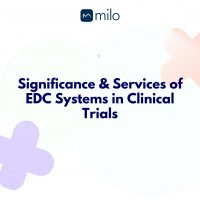EDC (Electronic Data Capture) system is transforming the field of Medtech and clinical trials in an unparalleled way. This software solution allows medical device companies to gather, store, and manage patient data digitally during clinical trials. It optimizes the data collection process, improves accuracy, enhances data security, and reduces costs. EDC systems can provide customized electronic case report forms (eCRFs) for researchers to collect and validate data. These systems can incorporate direct data capture, transcription from paper or electronic sources, and automatic transmission of data. The most important features of a clinical EDC system include eCRF builder, ePRO (Electronic Patient-Reported Outcomes), adverse events reporting modules, medication modules, eConsent, integration with connected devices and wearables, and integration options via APIs.
OVERVIEW :
- EDC systems streamline the data collection process for medical device companies conducting clinical trials.
- These systems enhance data accuracy, security, and reduce costs associated with paper-based forms and manual data entry.
- Clinical EDC systems offer features such as eCRF builders, ePRO capabilities, adverse events reporting, medication modules, and integration options with connected devices and CTMS.
- Data collection methods in EDC software include direct data entry, transcription from various sources, and automatic transmission from ePRO instruments and connected devices.
- By utilizing a comprehensive clinical EDC system, medical device companies can optimize data collection and achieve more efficient and reliable results in clinical studies.
- EDC systems offer multiple advantages for medical device companies conducting clinical trials.
Optimized Data Collection Process with MILO EDC
One of the main benefits of EDC systems like MILO, is their ability to streamline the data collection process. By deleting the need for paper-based forms and manual data entry, EDC systems save time and reduce errors in the data collection process. Researchers no longer have to spend hours transcribing data from paper forms onto the system, minimizing the risk of transcription errors. The electronic data capture ensures that data is entered directly into the system, improving efficiency and accuracy.
Data quality is paramount for reliable research results. MILO EDC simplifies the data collection process by minimizing human errors and providing an ergonomic experience for professionals. Integrated checks and automatic validations ensure high-quality data, reducing error correction costs and enhancing research accuracy. Researchers can optimize the study center management with EDC integrated into MILO DCT. Data centralization and seamless collaboration among team members simplify operations and the intuitive dashboards enable monitoring your research’s progress in real-time.
Data Security and Accessibility
Data security is pivotal in clinical research, for both patients and researchers. MILO EDC system is designed to ensure the confidentiality and integrity of your data. All collected information is encrypted and securely stored, compliant with stringent data protection regulations. Your research data is accessible only to the clinicians responsible for the clinical studies.
EDC systems upgrade data security and accessibility for clinical trials. Storing data digitally provide better protection against data loss or damage compared to physical paper forms. EDC software also enables secure access control, allowing only authorized personnel to access and manage the data. This ensures the confidentiality and integrity of sensitive patient information throughout the clinical trial.
Cost Reduction
By eliminating the need for printing and shipping paper forms, medical device companies can reduce expenses associated with paper-based data collection. Integrating EDC software can significantly reduce the cost of completing a clinical study. The labor costs associated with manual data entry and management are also minimized, as EDC systems automate these processes. Overall, EDC systems help to optimize resource allocation and reduce the financial burden associated with clinical trials.
Im summary, EDC systems are essential tools for medical device companies conducting clinical trials. They streamline the data collection process, enhance data security and accessibility, and contribute to cost reduction. By harnessing the benefits of EDC systems, companies can increase the efficiency and reliability of their clinical studies, ultimately advancing the development of innovative medical technologies.
Main Features of a Clinical EDC System
In order to effectively manage clinical trials, a robust clinical EDC system must possess several main features. These features include:
- Electronic Case Report Form (eCRF) Builder: A tailored eCRF builder enable researchers to create electronic case report forms that are tailored to their specific study requirements.
- Electronic Patient-Reported Outcomes (ePRO) Capabilities: The integration of ePRO capabilities allows the collection of patient-reported data, providing valuable insights into the patient experience and treatment outcomes.
- Adverse Events Reporting: Built-in modules for adverse events reporting allow researchers to track and report any adverse events that occur during the course of the trial, ensuring participant safety and compliance with regulatory requirements.
- Medication Modules: Incorporating medication modules into the EDC system enables the seamless tracking and monitoring of medication usage by trial participants, ensuring accurate analysis of treatment efficacy and safety.
- eConsent Functionality: The inclusion of eConsent functionality optimizes the process of obtaining informed consent from trial participants by allowing them to provide electronic consent, improving efficiency and reducing paperwork.
- Connected Devices Integration: Integration options for connected devices and wearables facilitate the seamless capture of data from these devices, such as vital signs, allowing for real-time monitoring and analysis.
- Clinical Trial Management System (CTMS) Integration: Seamless integration with a CTMS enables efficient data exchange and workflows between the EDC system and other components of the clinical trial management process, ensuring accurate and timely data management.
- Survey Data Collection: Additional features for survey data collection provide researchers with the ability to gather valuable information from participants through structured questionnaires, enriching the overall dataset and enhancing the study’s insights.
By incorporating these key features, a clinical EDC system empowers researchers with the necessary tools to optimize data collection, enhance participant engagement, and ensure the quality and integrity of clinical trial data.
Data Collection Methods in Clinical EDC Software
When it comes to gathering data in clinical trials, the use of Electronic Data Capture (EDC) software offers various convenient methods. These methods include direct data entry, transcription from paper or electronic sources, and automatic transmission. Each method is vital when it comes to streamlining the data collection process and ensuring its accuracy.
Direct Data Entry
Direct data entry is a direct method where researchers input data directly into the EDC system in real-time. This allows for immediate data capture and eliminates the need for manual transcription, reducing the chance of errors. It also facilitates efficient data processing and analysis, enabling researchers to access and utilize the data promptly.
Transcription from Paper or Electronic Sources
Another data collection method is transcription from paper or electronic sources. Researchers can efficiently transfer data from physical or digital documents into the EDC system. However, it is crucial to note that simply copying paper-based Case Report Forms (CRFs) into the electronic format may result in issues related to data quality. Careful review and validation of the transcribed data is necessary to maintain accuracy and integrity.
Automatic Transmission
By harnessing these data collection methods in clinical EDC software, researchers can streamline their data management processes, reduce errors, and improve overall efficiency. This ensures the integrity and reliability of the collected data, enabling more accurate and insightful analysis for successful clinical studies.
The automatic transmission method involves the seamless transfer of data from electronic Patient-Reported Outcome (ePRO) instruments and connected medical devices directly to the EDC system. This eliminates the need for manual data entry and minimizes the risk of human errors. By automating the data collection process, researchers can enhance efficiency, save time, and focus on more critical tasks related to the clinical trials.
Conclusion and Main Insights
Ultimately, the role of EDC Medtech in clinical trials cannot be overstated. These technologies streamline trial processes, significantly reducing the time required to build studies by as much as 50%. They also negate the need for custom programming, offering a more agile and adaptable environment for handling study amendments. Consequently, EDC Medtech solutions facilitate quicker implementations of study changes, highlighting their indispensable impact on clinical trial efficiency and patient care technology.
EDC systems play an essential role in the efficient management of clinical trials. By utilizing electronic data capture, medical device companies can streamline the data collection process, improving data accuracy and security, while reducing costs. Additionally, EDC systems offer essential features such as eCRF builders, ePRO capabilities, adverse events reporting, medication modules, and integration with connected devices and CTMS. These features allows optimized workflows, ensuring that clinical trial management becomes more organized and seamless.
At long last, the landscape of clinical studies is evolving at an unprecedented rate, largely due to the emergence of EDC Medtech solutions. Key players in the medical device market are shifting towards platforms like MILO EDC which leverages the ability to conduct complex trials with greater efficiency. The integration of these platforms by six of the Top 20 Pharma companies underscores the industry’s recognition of their robust capabilities. This embrace of EDC solutions is significantly impacting medical research, setting new precedents for trial management and data handling.
FAQ
What is an EDC system?
An EDC system, or Electronic Data Capture system, is a software solution that allows medical device companies to collect, store, and manage patient data digitally during clinical trials.
How can EDC systems benefit clinical trials?
EDC systems streamline the data collection process, improve data accuracy and security, and reduce costs by eliminating paper-based forms and manual data entry.







